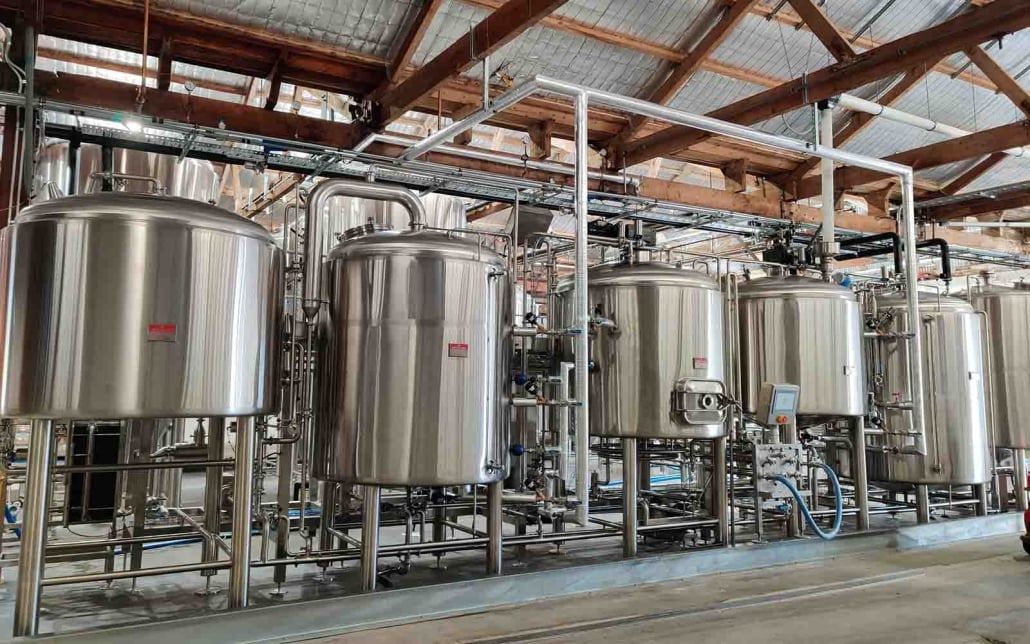Choosing the right size tank for brewing beer is a critical decision that can affect the efficiency, cost, and quality of your brewing process. Whether you’re a homebrewer scaling up or a commercial brewery planning for expansion, understanding the factors that influence tank size is essential. In this article, we’ll explore the key questions you need to consider to choose the right size tank for your brewing needs.
Get a turnkey solution for brewery equipment
If you plan to open or expand the brewery, you can contact Micet Craft directly. Our engineers will design and manufacture brewery equipment according to your brewing process. Of course, we will also provide you with a complete turnkey solution. Also, if you have any questions related to beer equipment, you can visit Micet Group to seek solutions.
Visit Micet Group official website:https://www.micetgroup.com/
What Factors Determine the Appropriate Tank Size for Brewing?
The size of the brewing tank you need is influenced by several factors, including your production goals, available space, and budget. Here are some of the primary considerations:
- Batch Size and Production Volume:
The most straightforward factor is the size of the batch you plan to brew. For homebrewers, this might mean 5 to 10 gallons, while commercial brewers may need tanks capable of handling several barrels of beer at a time. If you plan to increase production volume over time, it’s wise to invest in larger tanks or multiple tanks to accommodate growth. - Frequency of Brewing:
How often you plan to brew also impacts the size of the tank you’ll need. If you’re brewing daily or multiple times a week, you’ll need tanks that can handle continuous use without downtime. In contrast, if you brew less frequently, you might be able to get away with a smaller tank. - Type of Beer Being Brewed:
Different styles of beer require different fermentation times and conditions, which can influence tank size. For instance, lagers typically require longer fermentation periods than ales, meaning you might need more or larger tanks to manage extended production timelines. - Future Expansion Plans:
If you anticipate growing your brewery, it’s important to consider future needs when choosing tank sizes. Investing in slightly larger tanks now can save you from needing to purchase additional equipment later.
How Does Tank Size Affect the Brewing Process?
The size of your brewing tanks can have a significant impact on various stages of the brewing process, including efficiency, quality, and flexibility.
- Efficiency:
Larger tanks generally offer better efficiency, particularly in commercial brewing, where economies of scale come into play. A larger tank allows for bigger batch sizes, reducing the labor and time needed per unit of beer produced. However, this efficiency must be balanced against the risk of overproduction and the potential for wasted product if demand doesn’t meet supply. - Quality Control:
Consistency is key in brewing, and tank size plays a role in maintaining uniform quality across batches. Larger tanks can sometimes present challenges in ensuring even temperature distribution and yeast activity throughout the batch. It may require more sophisticated monitoring and control systems to maintain consistency in larger tanks. - Flexibility:
Smaller tanks offer greater flexibility, allowing you to experiment with different beer styles and recipes without committing to large volumes. They also allow for better inventory management, especially if you’re producing a variety of beers simultaneously.
What Are the Common Sizes for Brewing Tanks?
Brewing tanks come in a variety of sizes, each suited to different scales of production. Here are some of the most common sizes used in the industry:
- Homebrewing Tanks (5-10 gallons):
Ideal for hobbyists and small-batch production, these tanks are portable, easy to clean, and perfect for experimenting with different styles of beer. - Nano Brewery Tanks (1-3 barrels):
Nano breweries typically use tanks ranging from 1 to 3 barrels (31 to 93 gallons). These tanks are great for small-scale commercial production, allowing for enough volume to supply local markets without overwhelming storage and distribution capabilities. - Microbrewery Tanks (3-15 barrels):
Microbreweries, which produce beer on a slightly larger scale, often use tanks between 3 and 15 barrels (93 to 465 gallons). These tanks provide a balance between production volume and flexibility, making them suitable for a wide range of brewing styles. - Commercial Brewery Tanks (15+ barrels):
Larger commercial operations typically use tanks starting at 15 barrels and going up to several hundred barrels. These tanks are designed for high-volume production and require significant space, infrastructure, and investment.
How Do Space and Budget Constraints Influence Tank Size?
Choosing the right tank size is not only about brewing capacity but also involves practical considerations like space and budget.
- Space Constraints:
The physical footprint of brewing tanks can be substantial, especially in commercial settings. When selecting a tank size, you need to consider the available space in your brewery. This includes not just the floor area but also the ceiling height, as many tanks are tall. Additionally, you should account for space needed for maintenance, cleaning, and access to other equipment. - Budget Considerations:
Larger tanks are more expensive, not just in terms of the initial purchase but also in terms of installation, maintenance, and operational costs. It’s essential to balance the need for capacity with what your budget allows. Sometimes, starting with smaller tanks and gradually scaling up as your business grows is the most financially viable option. - Utility and Infrastructure Needs:
Larger tanks may require additional infrastructure, such as more robust plumbing, increased power supply, and advanced temperature control systems. These added costs should be factored into your decision-making process.
FAQs
1. What size tank is recommended for a homebrew setup?
For homebrewers, tanks between 5 and 10 gallons are typically sufficient. These sizes allow for manageable batches and are easier to handle and clean.
2. How do I determine the right tank size for a commercial brewery?
Consider your production goals, space availability, and budget. Commercial breweries often start with tanks of 15 barrels or more, but the exact size should be based on your specific needs and future expansion plans.
3. Can I use multiple smaller tanks instead of one large tank?
Yes, using multiple smaller tanks can offer greater flexibility, especially if you produce various beer styles. It also allows for staggered production, reducing the risk of downtime.
4. How does the type of beer affect the tank size needed?
Certain beer styles, such as lagers, require longer fermentation times, which may necessitate larger or additional tanks to accommodate the extended production period.



